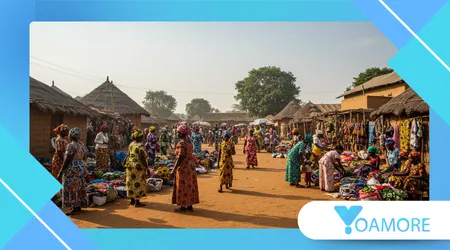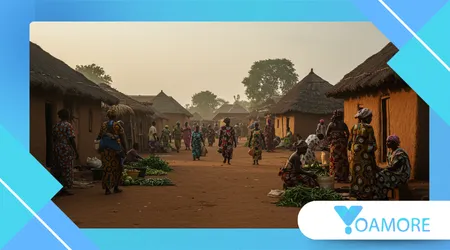Village of the Twins: The Microculture of Igbo-Ora, Nigeria

The Nigerian town of Igbo-Ora, often called the Village of the Twins, holds a fascinating secret within its vibrant community and unique microculture.
Anúncios
People often wonder what could possibly explain this extraordinary density of double births, a phenomenon unlike anywhere else.
We will explore the scientific theories, the local traditions, and the powerful sense of identity that makes this town a truly remarkable place.
An Unprecedented Statistical Anomaly
In this small town in Oyo State, Nigeria, almost every family boasts at least one set of twins, truly challenging global birth statistics.
Globally, the twin birth rate is around 12 per 1,000 births, yet in Igbo-Ora, this figure skyrockets. Scientific studies and hospital records suggest a rate closer to an astonishing 50 per 1,000 births.
Anúncios
This striking divergence from the norm positions the Village of the Twins as a global outlier for dizygotic (non-identical) twinning.
The question is less about if twins are born, and more about the cultural and biological forces at play.
For the community, twins are a celebrated part of life, woven into the very fabric of their existence.
Birth Rate Comparison
The difference in birth rates is visually striking when compared to the global average. You can see how Igbo-Ora’s rate is exceptionally high.
| Location | Twin Births (per 1,000 births) |
| Global Average | 12 |
| Igbo-Ora, Nigeria |
As you can see, the ratio here is nearly five times the global norm, prompting years of intense scientific investigation and local folklore.
The Competing Explanations for Twinning
For decades, experts have sought a definitive answer, exploring a complex interplay of genetic, dietary, and environmental factors.
Current research indicates that the phenomenon is likely a combination of these elements, not a single, isolated cause.
Local inhabitants offer their own compelling and deeply held beliefs about the high frequency of double births.
+ How Honorifics Create Hierarchies in Japanese and Korean
The Genetic Theory: A Yoruba Trait
The people of Igbo-Ora belong to the Yoruba ethnic group, which already has one of the world’s highest twinning rates.
Scientists suggest that a specific, inherited hyper-ovulation gene or a genetic predisposition could be strongly contributing.
This genetic theory implies a biological inheritance passed down through generations within this localized population.
The Dietary Hypothesis: Yams and Okra
A much-discussed theory centers on the traditional local diet, rich in specific root vegetables like yams and the leaves of the okra plant (known locally as Ilasa).
Some researchers hypothesize that these foods contain natural phytoestrogens.
These hormone-like compounds might stimulate the ovaries to release multiple eggs, thus significantly increasing the likelihood of dizygotic twins.
It’s a captivating hypothesis, but the same foods are consumed in neighboring communities without the same outcome.
This fact suggests that diet alone cannot be the sole explanation for the situation in the Village of the Twins.
+ Meet the Reindeer Herders of Siberia’s Yamal Peninsula
New Scientific Directions: Epigenetics
Contemporary research is now leaning toward the concept of epigenetics—how environmental factors can influence gene expression.
A study on community perceptions regarding the causes of high dizygotic twinning rates suggested that nutritional or other environmental factors might produce epigenetic modifications.
Researchers theorize that a confluence of underlying genetics and changes caused by diet could be the real answer.
Isolating this factor could revolutionize fertility treatments worldwide.
Culture, Identity, and Celebration

Beyond the scientific intrigue, the cultural response to this phenomenon is perhaps the most captivating part of the Igbo-Ora story.
Twins are not just accepted; they are deeply revered, possessing a special spiritual and cultural significance.
The Yoruba call twins Ibeji, giving them distinct and honorific names.
The first-born twin is always called Taiwo (meaning “to taste the world”) and the second Kehinde (meaning “the one who came last”).
+ The Camel Whisperers of Rajasthan: A Look at Their Secret Signals
The World Twins Festival
The community’s pride culminates each year in the vibrant and world-famous World Twins Festival.
This massive cultural event celebrates the unique heritage and strong bonds of twinship.
Thousands of twins, dressed in matching attire, flock to Igbo-Ora from across Nigeria and beyond to participate in parades and ceremonies.
Seeing hundreds of pairs of twins together is a sight that truly encapsulates the essence of the Village of the Twins.
The festival, held annually in October, transforms the town into a magnet for international media and tourists.
It provides a vital platform for cultural preservation and for generating revenue that supports the local community.
For a sense of the festival’s scale, visit the official website (example link) for updates on the 2025 event and its schedule.
The Human Element: Daily Life in Igbo-Ora
Life in Igbo-Ora normalizes what the rest of the world considers extraordinary.
For the people who live here, having two babies at once is a common reality, not a surprising medical event.
Every marketplace, school, and social gathering features double vision, making the phenomenon utterly commonplace.
For example, imagine a teacher in the town; assembling a class photo for their elementary school would require twice the effort to ensure every single pair of matching faces is captured correctly.
A strong sense of collective identity develops when so many people share this unique experience.
It is a unifying factor that cements social bonds and familial support systems.
The cultural norms embrace the challenge of raising two children simultaneously, turning a potential hardship into a communal strength.
Challenges and the Future
Despite the celebration, the reality of being the world’s twin capital comes with its own set of challenges.
Raising multiple babies at once requires more resources, presenting financial and logistical strains on families.
Local infrastructure, particularly healthcare, faces constant pressure to adequately support the high rate of multiple births.
Igbo-Ora urgently needs increased access to specialized maternal care and financial aid to help families manage the costs associated with caring for twins.
The attention brought by its unique status has been a double-edged sword, bringing both recognition and a spotlight on resource deficiencies.
The economic importance of twinning has led to a focus on cultural preservation and attracting tourism.
As an authentic and rich microculture, the town is finding ways to leverage its distinction into sustainable community development.
A Microculture of Duality
In Igbo-Ora, duality is not just a biological event; it is a way of life, an identity, and a shared history.
The experience is a powerful analog for human connection itself—a constant reminder of balance and two sides to every story.
This deep respect for twinship influences their art, their naming conventions, and their spiritual beliefs, demonstrating a true microculture.
Observing this community gives us a profound, real-world lesson in genetic persistence and cultural adaptation.
Consider the story of the Oladapo family: parents of two sets of dizygotic twins.
The father often jokes that he buys every item in pairs—two school uniforms, two pairs of shoes, two identical birthday cakes—a running logistical challenge that highlights the delightful double-duty of their everyday life.
It is a culture that has evolved to not only accommodate but to celebrate the statistical anomaly of its existence. Village of the Twins isn’t just a nickname; it’s a testament to a resilient and unique people.
Why the Igbo-Ora Phenomenon Matters
The ongoing study of Igbo-Ora holds immense value for global fertility and genetic research.
Understanding the factors driving their high dizygotic twinning rate could unlock new pathways for fertility treatments globally.
It is an unparalleled “living laboratory” offering crucial insights into the mechanisms of human reproduction.
Is it possible that the secrets to reproductive health are hidden within a local vegetable, or a gene that has flourished due to cultural factors?
The research provides a compelling example for scientists exploring the relationship between diet, genetics, and environment.
Professor Akhere Omonkhua’s work, which investigates the role of phytoestrogens in local foods, exemplifies the cutting-edge efforts.
Her work continues to analyze the complex relationship between diet and reproductive biology.
(Source: ResearchGate, Community perceptions on causes of high dizygotic twinning rate in Igbo-Ora, South-west Nigeria: A qualitative study).
A Lasting Legacy
The Village of the Twins offers us a rare window into a culture where the unusual is the norm.
It is a powerful narrative about cultural pride and scientific wonder.
They have transformed a biological peculiarity into a source of tremendous community strength and global fascination.
We can learn a lot from the Yoruba people of Igbo-Ora about embracing uniqueness.
Their example shows how a community can not only adapt to a distinctive demographic reality but also elevate it to an inspiring cultural institution.
To delve deeper into the anthropological significance of the Yoruba’s Ibeji tradition, exploring their spiritual and artistic representations is highly recommended (example link).
Frequently Asked Questions
What is the current twin birth rate in Igbo-Ora?
The current twin birth rate in the town is estimated to be exceptionally high, ranging between 45 and 50 per 1,000 births, significantly above the global average of 12 per 1,000.
Are the twins in Igbo-Ora identical or non-identical?
The unusually high rate is specifically attributed to a high incidence of dizygotic (non-identical) twins, suggesting a factor that causes hyper-ovulation in the mothers.
What are the main theories explaining the high twin birth rate?
Leading theories include genetic factors within the Yoruba ethnic group, the local diet rich in compounds from yams and okra, and new studies pointing to epigenetic factors influenced by both diet and environment.
Do the people of Igbo-Ora have a special name for twins?
Yes, the Yoruba refer to twins as Ibeji. The first twin is traditionally named Taiwo, and the second is named Kehinde, names which reflect their spiritual and social roles.
When is the World Twins Festival held?
The World Twins Festival is an annual celebration usually held in the month of October. It brings together thousands of twins for a vibrant cultural celebration.
